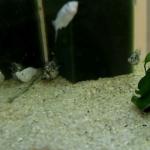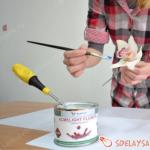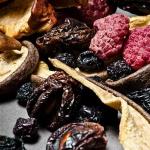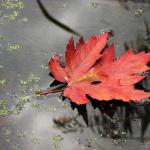Powdery mildew (sphere library)
Powdery mildew is a fungal disease that affects a huge number of ornamental, vegetable, fruit and berry plants.
The most common pathogens - fungi of the species Podosphaera fuliginea and Erysiphe cichoracearum - are indiscriminate, they affect a wide range of plants: melons and gourds most often suffer from horticultural crops: cucumbers, pumpkins, zucchini, melons, watermelons; berry bushes: gooseberries, currants, fruit trees, as well as berry bushes are affected.
There are also specific pathogens that are characteristic of specific plants, for example, the causative agent of powdery mildew of grapes is the species Oidium tuckeri. Therefore, powdery mildew on grapes is called: Oidium.
Garden flowers are very susceptible to the sphere library, sometimes with a cut from a store or garden, powdery mildew also gets on indoor flowers.
Symptoms
Powdery mildew is easy to identify, as it has quite characteristic symptoms. It begins with the appearance of small white spots on the upper side of the leaf. Gradually, the spots increase and cover the entire leaf as a whole, moving to the entire aerial part of the plant. As the disease progresses, the spots become larger, denser and whiter: the bushes look like they have been doused with lime mortar. And upon closer inspection, the leaves seem to be covered with the thinnest layer of cotton wool or cobwebs - this is a white mycelium of the fungus, consisting of numerous conidia collected in chains.

In fruit plants, the growth of the bush is disrupted, the wood on the growing shoots does not ripen, as a result, the plants suffer greatly from frost, especially for grapes. In addition, the sphere library very quickly moves from leaves to ovaries and fruits, you can be left completely without a crop, since berries and fruits affected by white bloom are unsuitable for food.
With vegetables, the situation is more complicated - since tropical plants consume a huge amount of nutrients for the growth and formation of fruits, very often they simply cannot cope with the infection and die. Powdery mildew seriously threatens cucumbers and tomatoes.
Where does powdery mildew come from
Spheroteca pathogens reproduce both sexually and asexually.
- Asexual reproduction occurs with the help of conidia - these are motionless spores, so named from the Greek konia - dust and eidos - view. It is the chains of conidia that we see on the leaves of infected plants in the form of a white coating, they easily break away from each other and are carried by the wind for a decent distance. So, throughout the summer season, new shoots and plants are regularly re-infected.
- Sexual reproduction is carried out through spore-bearing structures - cleistothecia. This fruiting body of the fungus is composed of very densely intertwined hyphae and can contain millions of spore sacs, each typically containing four to eight ascospores. Cleistothecia hibernate on fallen leaves, and in spring the ascospores mature, are released and give rise to a new focus of infection.

At the moment when cleistothecia are formed, the plaque on the leaves turns from white to gray, then brown - the fruiting bodies themselves (cleistothecia) themselves are brown or black in color, and the dimensions do not exceed 0.2 mm.
Conditions for the development of powdery mildew
The incubation period with favorable factors for powdery mildew is 5 to 10 days, depending on the temperature. For example, at a temperature of about +15°C, the period from the onset of infection to the formation of conidia is about five days.
The favorable temperature for the formation of conidia is from +5°C to +28°C, but mass development occurs at +20°C. Contributes to the disease relative humidity of 60-80% in the absence of precipitation. Directly during rains, the spread of the disease is inhibited - the colonies of conidia remain on the leaves, but when the precipitation stops, the soil evaporates moisture for a long time, and the pathogen develops rapidly.
Therefore, it is after heavy rains that the development of the sphere library occurs rapidly, in 2-3 days a gooseberry bush can become covered with a white coating.
The denser the planting of seedlings, flowers, vegetables, tree crowns, the higher the air humidity, the less wind movement and the stronger local infection occurs within the garden plot.
What contributes to the rapid development of powdery mildew
Infection occurs most rapidly when alternating warm, dry days and rains, then humidity does not fall below 60%. Although infection can occur even at a relative humidity of about 50%.
The introduction of an excess amount of nitrogen fertilizers or weather conditions that favor the conversion of nitrogen into an assimilable form increase the development of fungal diseases (oidium, rust, septoria, etc.). Excess - means more than 0.6 kg of active substance per 1 weave.

The conditions necessary for the maturation of spores differ in different types of powdery mildew pathogens, for example, with powdery mildew of grapes (Oidium), mycelium grows better at 25–30 ° C, i.e. the hotter the weather, the faster the vineyards are affected.
Young leaves are most susceptible to damage by the sphere library - within 16-20 days after deployment.
Powdery mildew prevention
If powdery mildew has already been noticed in your garden plot, in early spring, as soon as the leaves begin to unfold on fruit bushes, spray the bushes with Topaz or Vectra (their action is aimed specifically at powdery mold). After 2 weeks, repeat the spraying of the leaves and the resulting ovaries. The third spraying will be after harvest.
Follow the general rules of prevention:
- Destroy infected plant debris by burning all leaves and shoots that show signs of the disease.
- Weed weeds, many are prone to infection.
- Observe crop rotation, do not re-plant crops susceptible to powdery mildew in the same place.
- Purchase seedlings and seeds of plants that are genetically resistant to disease.
- Ensure sufficient air circulation, avoid crowding, thin out seedlings and seedlings.
- Disinfect the tools you use for trimming or tying (ribbons and ropes, secateurs, etc.).
- If you use the principle of sprinkling, then water vegetables and berries in the morning so that the plants have the opportunity to dry out during the day. Even better, choose a drip irrigation system to help keep the leaves dry.
- Do not overdo it with nitrogen fertilizers, but apply phosphorus-potassium fertilizers regularly.
Powdery mildew serum
Whey works best as a preventative rather than a cure, and should be used if you notice infected plants, trees or weeds somewhere near your site. Susceptible crops need to be protected: gooseberries, currants, roses, etc.
There is no difference between what to spray - milk or whey (backflow) - only in price, both products contain milk proteins, and we need them.

How exactly the whey works against the fungus, no one knows for sure, it is assumed that milk proteins have an antiseptic effect when exposed to sunlight. Therefore, the treatment with milk and whey is carried out not in the evening, but at 10-11 in the morning in sunny weather. Moisten both sides of the leaves with a solution of milk until it flows to the ground.
How to dilute whey with water against powdery mildew: for 1 part of milk (whey), we take 2-3 parts of water. The solution is sprayed on the leaves of plants every 10-14 days. If there is a desire - it is possible more often - once a week.
- Sometimes you can find a recipe for powdery mildew, where reverse, whey, sour milk or kefir (yogurt) are used in a 1:10 dilution with cold water. Believe me - it does not work, too weak concentration! We breed 1:2 or 1:3, and repeat every week.
Powdery mildew ash
Good prevention of the sphere library, i.e. spraying before the symptoms of the disease appear - ash treatment. To do this, take 1 kg of clean wood ash, sifted from debris, and pour 10 liters of water. Leave the solution to infuse for 3-5 days, stir occasionally. Add a couple of tablespoons of grated soap. Strain the solution through a thin cotton cloth into the sprayer so as not to clog the sprayer.
Powdery mildew - control measures
If powdery mildew has already cleared up on fruit and berry bushes, flowers or vegetables, not only general agricultural techniques are needed, such as loosening and thinning, but also the use of various fungicides or chemicals. And even at this stage, it may already be too late, for example, on berries with clearly expressed signs of the disease, it is too late to use chemicals, because poisons remain in fruits for up to 20-30 days. On grapes, you need to start processing from powdery mildew at the very beginning of the growing season, when the shoots have formed only 3-5 leaves.
Consider the most common methods of treatment.
Powdery mildew iodine
We take medical iodine, measure out with a syringe 10 ml and dissolve in 10 liters of water. We thoroughly moisten the leaves of infected plants with this solution.
On roses, you can use a more concentrated solution: 20 ml of alcohol tincture of iodine per 7 liters of water.
If you do not have a syringe to measure out, count as drops, for example, to treat powdery mildew cucumbers, 30 drops of iodine per 10 liters of water. But since cucumbers do not tend to retain moisture on the leaves, you need to add an adhesive: a couple of tablespoons of grated laundry soap or green potash.
Fitosporin-M from powdery mildew
How to breed:
- Fitosporin-M powder - 1 g per 1 liter of water or 10 g per 10 liters of water
- Fitosporin-M liquid - 0.6 ml per 1 liter of water or 6 g per 10 liters of water 20 drops per 200 ml of water.
- Fitosporin-M paste, how to breed, read
Mouthwash
In America, in gardening centers, it is recommended to use a universal ethanol-based mouthwash (antibacterial) from the sphere library. We can see similar ones on sale, for example, "Forest Balsam". Jeff Gillman, director of the Botanical Gardens at the University of North Carolina and author of books on plants ("Organic Gardening"), claims that this recipe for powdery mildew works effectively: one part mouthwash and three parts water. True, he warns that such a solution should be used with caution - it can damage young, just unfolded leaves. Therefore, it is better to use commercial fungicides.
Our compatriot, the famous gardener Galina Kizima, advises: it is important to carry out preventive spraying of the garden in the first half of summer. According to her recommendations, we do the following:
- We take a bottle of 1.5 liters, pour 500 ml of water.
- We throw 2-3 grains of the Healthy Garden preparation and 2-3 grains of the Ecoberin preparation into the bottle.
- Close the lid and shake the bottle vigorously until the grains dissolve.
- Add water to a volume of 1 liter.
- Add 6 drops of Zircon, 4 drops of Cytovit, 8 drops to the solution.
This solution should be sprayed with all fruit and berry bushes and plants, seedlings of vegetables, young trees. For powdery mildew, spray as soon as the first leaves open, then after flowering and after harvest.
Galina Alexandrovna calls this cocktail protective against a complex of diseases and pests.
Naturally, for a summer cottage, you need to prepare a large volume of solution, it is better to cook in small batches, or count for 5 liters of water. Do not store the solution! Do not spray in the sun, spray in cloudy weather or in the evening.
Powdery mildew fungicides
Copper soap solution: 20-30 g of copper sulfate and 200-300 g of soap per 10 liters of water. To prepare copper sulphate and soap separately, dissolve in a small amount of hot water, then pour the copper sulphate solution in a thin stream into the soap solution, with constant stirring. Strain, spray.
Copper soda solution: Dilute 50 g of soda ash and 200 g of soap (household, tar) in 2 liters of hot water. Separately, dilute 10 g of copper sulfate in a glass of water, pour in a thin stream into a solution of soda and soap. Add water to 10 liters of solution volume. Stir, strain, spray.
Of the effective fungicides against powdery mildew, you can choose: bayleton, but, quadris, rayok, scor, tilt, topaz, topsin, thiovit jet, hom, oxychom, etc. Some of the drugs are available in small packaging for personal household plots, some can only be obtained in collective purchases, as they are sold for agriculture in large containers (quadris, bravo, bayleton, etc.)
- Agrolekar, Chistoflor, Prognoz - contain propiconazole, dilute 10 ml per 10 liters of water, maximum 3 treatments: spraying at the beginning of the growing season, before flowering and after harvesting.
- Rayok, Chistotsvet contain difenoconazole, we dilute 2 g per 10 liters of water, a maximum of 4 treatments: the first - along the green cone, the rest - after 12-14 days. For flowers and ornamental plants and shrubs, dilute 2 ml per 5 liters of water.
- , contains penconazole, we dilute 6-8 g per 10 liters of water, no more than 4 treatments, the waiting period is 20 days.
- Vectra, contains bromuconazole, we dilute 3 mg per 10 l, only 3 treatments: the first - after flowering, the second - after 12-15 days, the third - after harvesting, do not spray during flowering!
- Alirin and Gamair, dilute 2 tablets per 1 liter of water.
The consumption of the working solution is up to 2 liters per bush of currant, gooseberry or young fruit tree 5-6 years old, up to 5 liters per large fruit-bearing tree. When spraying grapes, the fungicide consumption is 10-15 liters per hundred square meters.
It is not recommended to use fungicides based on the same active ingredient more than three times, although some manufacturers recommend four times. Stop all fungicide treatments 20 days before harvest!




